Removal and Temporary Cyst Formation of Gymnodinium catenatum (Dinophyceae) Using Calcium Bentonite Clay and Zeolite
Abstract
1. Introduction
2. Materials and Methods
2.1. Cultivation
2.2. Preparation of Flocculants
2.3. X-Ray Microanalysis of Flocculants by the Scanning Electron Microscope
2.4. Experimental Design
2.5. Percentage of Removal Efficiency
2.6. Microscope Observation
2.7. Photosynthetic Pigments
2.8. Statistical Analysis
3. Results
3.1. Cell Growth
3.2. X-Ray Microanalysis of Flocculants by the Scanning Electron Microscope
3.3. Calcium Bentonite
3.4. Zeolite
3.5. Percentage Removal
3.6. External Effects on Cells of G. catenatum
4. Discussion
5. Conclusions
Author Contributions
Funding
Institutional Review Board Statement
Data Availability Statement
Acknowledgments
Conflicts of Interest
References
- Gobler, C. Climate Change and Harmful Algal Blooms: Insights and perspective. Harmful Algae 2020, 91, 101731. [Google Scholar] [CrossRef]
- Smayda, T. Harmful algal blooms: Their ecophysiology and general relevance to phytoplankton blooms in the sea. Limnol. Oceanogr. 1997, 42 Pt 2, 1137–1153. [Google Scholar] [CrossRef]
- Anderson, D.; Glibert, P.; Burkholder, J. Harmful algal blooms and eutrophication: Nutrient sources, composition, and consequences. Estuaries 2002, 25, 704–726. [Google Scholar] [CrossRef]
- Anderson, D.; Cembella, A.; Hallegraeff, G. Progress in understanding harmful algal blooms: Paradigm shifts and new technologies for research, monitoring, and management. Ann. Rev. Mar. Sci. 2012, 4, 143–176. [Google Scholar] [CrossRef]
- Hallegraeff, G.; Anderson, D.; Belin, C.; Bottein, M.-Y.D.; Bresnan, E.; Chinain, M.; Enevoldsen, H.; Iwataki, M.; Karlson, B.; McKenzie, C.H.; et al. Perceived global increase in algal blooms is attributable to intensified monitoring and emerging bloom impacts. Commun. Earth Environ. 2021, 2, 117. [Google Scholar] [CrossRef]
- Hallegraeff, G.; Enevoldsen, H.; Zingone, A. Global harmful algal bloom status reporting. Harmful Algae 2021, 102, 101992. [Google Scholar] [CrossRef]
- Kudela, R.; Gobler, C. Harmful dinoflagellate blooms by Cochlodinium sp.: Global expansion and ecological strategies facilitating bloom formation. Harmful Algae 2012, 14, 71–86. [Google Scholar] [CrossRef]
- Sanseverino, I.; Conduto, D.; Pozzoli, L.; Dobricic, S.; Lettieri, L. Algal Bloom and Its Economic Impact; EUR 27905 EN; EU Publications: Luxembourg, 2016. [Google Scholar]
- Anderson, D. Approaches to monitoring, control and management of harmful algal blooms (HABs). Ocean Coast. Mang. 2009, 52, 342–347. [Google Scholar]
- Trainer, V.; Bates, S.; Lundholm, N.; Thessen, A.; Adams, N.; Cochlan, W. Pseudo-nitzschia physiological ecology, phylogeny, toxicity, monitoring and impacts on ecosystem health. Harmful Algae 2012, 14, 271–300. [Google Scholar] [CrossRef]
- Young, R.; Sharpe, R.; Barciela, R.; Nichols, G.; Davidson, K.; Berdalet, E.; Lora, E.; Fleming, L. Marine harmful algal blooms and human health: A systematic scoping review. Harmful Algae 2020, 98, 101901. [Google Scholar] [CrossRef] [PubMed]
- Rounsefell, G.; Evans, J. Large-Scale Experimental Test of Copper Sulfate as a Control for the Florida Red Tide; US Department of the Interior, Fish and Wildlife Service: Washington, DC, USA, 1958. [Google Scholar]
- Jeong, H.; Kim, H.; Kim, K.; Park, K.H.; Kim, S.T.; Du Yoo, Y.; Song, J.Y.; Kim, J.S.; Seong, K.A.; Yih, W.H.; et al. NaOCl produced by electrolysis of natural seawater as a potential method to control marine red-tide dinoflagellates. Phycologia 2002, 41, 643–656. [Google Scholar]
- Gallardo-Rodríguez, J.; Astuya-Villalón, A.; Llanos-Rivera, A.; Avello-Fontalba, V.; Ulloa-Jofré, V. A critical review on control methods for harmful algal blooms. Rev. Aquac. 2019, 11, 661–684. [Google Scholar]
- Balaji-Prasath, B.; Wang, Y.; Su, Y.; Hamilton, D.; Lin, H.; Zhen, L.; Zhang, Y. Methods to control harmful algal blooms: A review. Environ. Chem. Lett. 2022, 20, 3133–3152. [Google Scholar] [CrossRef]
- Sengco, R. The Aggregation of Clay Minerals and Marine Microalgal Cells: Physicochemical Theory and Implications for Controlling Harmful Algal Blooms. Ph.D. Thesis, Long Island University, New York, NY, USA, 2001. [Google Scholar]
- Sengco, R.; Li, A.; Tugend, K.; Kulis, D.; Anderson, D. Removal of red- and brown- tide cells using clay flocculation. I. Laboratory culture experiments with Gymnodinium breve and Aureococcus anophagefferens. Mar. Ecol. Prog. Ser. 2001, 210, 41–53. [Google Scholar] [CrossRef]
- Sengco, R. Prevention and control of Karenia brevis blooms. Harmful Algae 2009, 8, 623–628. [Google Scholar] [CrossRef]
- Yu, Z.; Song, X.; Cao, X.; Liu, Y. Mitigation of harmful algal blooms using modified clays: Theory, mechanisms, and applications. Harmful Algae 2017, 69, 48–64. [Google Scholar] [CrossRef] [PubMed]
- Shirota, A. Red Tide problem and counter measures (1). Int. J. Aquat. Fish Technol. 1989, 1, 195–293. [Google Scholar]
- Sengco, R.; Anderson, D. Controlling Harmful Algal Blooms through clay flocculation. J. Eukaryot. Microbiol. 2004, 51, 169–172. [Google Scholar] [CrossRef]
- Lewis, M.; Dantin, D.; Walker, C.; Kurt, J.; Green, R. Toxicity of clay flocculation of the toxic dinoflagellate, Karenia brevis, to estuarine invertebrates and fish. Harmful Algae 2003, 2, 235–246. [Google Scholar] [CrossRef]
- Archambault, M.; Bricelj, M.; Grant, J.; Anderson, D. Effects of suspended and sedimented clays on juvenile hard clams, Mercenaria mercenaria, within the context of harmful algal mitigation. Mar. Biol. 2004, 144, 553–565. [Google Scholar]
- Orizar, I.; Rivera, P.; San Diego-McGlone, M.; Azanza, R. Harmful Algal Bloom (HAB) mitigation using ball clay: Effect non-target organisms. J. Environ. Sci. Manag. 2013, 16, 36–43. [Google Scholar]
- Band-Schmidt, C.; Durán-Riveroll, L.; Bustillos-Guzmán, J.; Leyva-Valencia, I.; López-Cortés, D.; Núñez-Vázquez, E.; Hernández-Sandoval, F.; Ramírez-Rodríguez, D. Paralytic toxin producing dinoflagellates in Latin America, ecology and physiology. Front. Mar. Sci. 2019, 6, 42. [Google Scholar] [CrossRef]
- Cembella, A.; Band-Schmidt, C. Gymnodinium catenatum. Harmful algal species fact sheets. In Harmful Algal Blooms: A Compendium Desk Reference; Shumway, S.E., Burkholder, J.M., Morton, S.L., Eds.; Wiley Blackwell: Hoboken, NJ, USA, 2018; pp. 605–611. [Google Scholar]
- Mee, D.L.; Espinosa, M.; Diaz, G. Paralytic Shellfish Poisoning with a Gymnodinium catenatum Red Tide on the Pacific Coast of México. Mar. Environ. Res. 1986, 19, 77–92. [Google Scholar] [CrossRef]
- Band-Schmidt, C.; Bustillos-Guzmán, J.; López-Cortés, D.; Gárate-Lizárraga, I.; Núñez-Vázquez, E.; Hernández-Sandoval, F. Ecological and physiological studies of Gymnodinium catenatum in the Mexican Pacific: A review. Mar. Drugs 2010, 8, 1935–1961. [Google Scholar] [CrossRef]
- Núñez-Vázquez, E.; Band-Schmidt, C.; Bustillos-Guzmán, J.; López-Cortés, D.; Cordero-Tapia, A.; Heredia-Tapia, A.; García-Mendoza, E.; Ruíz-de la Torre, M.; Medina-Elizalde, J. Impactos de los FAN en la Salud Pública y Animal (Silvestres y de Cultivo) en el Golfo de California. In Florecimientos Algales Nocivos en México; García-Mendoza, E., Quijano-Scheggia, S.I., Olivos-Ortiz, A., Núñez-Vazquez, E., Eds.; CICESE: Ensenada, Mexico, 2016; ISBN 978-607-95688-5-6. [Google Scholar]
- García-Mendoza, E.; Medina, J.; Rivas, D.; Ruiz, M.C.; Bustillos-Guzmán, J.; Núñez-Vázquez, E.J. Paralytic shellfish toxins cause seabirds and marine mammal’s massive mortalities in the upper gulf of California. In Proceedings of the 17th International Conference on Harmful Algae, Florianopolis, Brazil, 9–14 October 2016; p. 83. [Google Scholar]
- Medina-Elizalde, J.; García-Mendoza, E.; Turner, A.D.; Sánchez-Bravo, Y.A.; Murillo-Martínez, R. Transformation and Depuration of Paralytic Shellfish Toxins in the Geoduck Clam Panopea globosa from the Northern Gulf of California. Front. Mar. Sci. 2018, 5, 335. [Google Scholar] [CrossRef]
- Poot-Delgado, C.; Yuri, B.; Okolodkov, Y.; Aké-Castillo, J.; Rendón-Von Osten, J. Annual cycle of phytoplankton with emphasis on potentially harmful species in oyster beds of Terminos Lagoon, southeastern Gulf of Mexico. Reprod. BioMed. Online 2015, 50, 465–477. [Google Scholar]
- Poot-Delgado, C.; Okolodkov, Y.; Rendón-von Osten, J. Spatio-temporal Variation of Harmful Planktonic Microalgae and Cyanobacteria Along the Central Coast of Campeche, Southeastern Gulf of Mexico. Bull. Environ. Contam. Toxicol. 2022, 108, 15–23. [Google Scholar] [CrossRef]
- Alonso-Rodríguez, R.; Páez-Osuna, F. Nutrients, phytoplankton and harmful algal blooms in shrimp ponds: A review with special reference to the situation in the Gulf of California. Aquaculture 2003, 219, 317–336. [Google Scholar] [CrossRef]
- Song, X.; Zhang, Y.; Yu, Z. An eco-environmental assessment of harmful algal bloom mitigation using modified clay. Harmful Algae. 2021, 107, 102067. [Google Scholar] [CrossRef]
- Anderson, D.; Kulis, D.; Binder, B. Sexuality and cyst formation in the dinoflagellate Gonyaulax tamarensis: Cyst yield in batch cultures. J. Phycol. 1984, 20, 418–425. [Google Scholar] [CrossRef]
- Vidussi, F.; Claustre, H.; Bustillos-Guzmán, J.; Cailleau, C.; Marty, J. Rapid HPLC method for determination of phytoplankton chemotaxinomic pigments: Separation of chlorophyll a from divinyl-chlorophyll a and zeaxanthin from lutein. J. Plank. Res. 1996, 18, 2377–2382. [Google Scholar] [CrossRef]
- Montoura, R.; Repeta, D. Calibration methods for HPLC. In Phytoplankton Pigments in Oceanography: Guidelines to Modern Methods; Jeffrey, S., Mantoura, R., Wright, S., Eds.; UNESCO: Paris, France, 1997; pp. 407–428. [Google Scholar]
- Avnimelech, Y.; Troeger, B.; Reed, L. Mutual flocculation of algae and clay: Evidence and implication. Science 1982, 216, 63–65. [Google Scholar] [CrossRef]
- Pierce, R.; Henry, M.; Higham, C.; Blum, P.; Sengco, M.; Anderson, D. Removal of harmful algal cells (Karenia brevis) and toxins from seawater culture by clay flocculation. Harmful Algae 2004, 3, 141–148. [Google Scholar] [CrossRef]
- Padilla, L.; San Diego-McGlone, M.; Azanza, R. Exploring the potential of clay in mitigating Pyrodinium bahamense var. compressum and other harmful algal species in the Philippines. J. Appl. Phycol. 2010, 22, 761–768. [Google Scholar] [CrossRef]
- García-Gutiérrez, M. Glosario de Términos Geológicos; Consejo de Recursos Minerales: Pachuca, Mexico, 2003; p. 781. [Google Scholar]
- Rivera, P.; Azanza, R.; Diego-McGlone, M.; Sellner, K. Notable physiological and morphological effects of Ball clay addition on bloom forming organisms Pyrodinium bahamense, Gymnodinium catenatum and Alexandrium catanella. In Proceedings of the 16th International Conference on Harmful Algae (ICHA 16 NZ), Wellington, New Zealand, 27–31 October 2014. [Google Scholar]
- Rivera, P.; Azanza, R. Mitigating Toxic Algal Blooms: Removal and effects of ball clay addition on the Paralytic Shellfish Toxin (PST) producing dinoflagellates. In Proceedings of the 13th National Symposium in Marine Science (PAMS 13), General Santos City, Philippines, 22–24 October 2015. [Google Scholar]
- Fausto-Sotelo, E.; Alonso-Rodríguez, R. Control de Florecimientos Algales Nocivos con aplicación en la camaronicultura. In Florecimientos Algales Nocivos en México; García-Mendoza, E., Quijano-Scheggia, S., Olivos-Ortiz, A., Núñez-Vázquez, E., Eds.; CICESE: Ensenada, México, 2016. [Google Scholar]
- Cuéllar-Martínez, T.; Alonso-Rodríguez, R.; Voltolina, D.; Morquecho, M. Effectiveness of coagulants-flocculants for removing cells and toxins of Gymnodinium catenatum. Aquaculture 2016, 452, 188–193. [Google Scholar] [CrossRef]
- AziziHariri, P.; Hossain, I.; Burni, F.; Raghavan, S.; Lovko, V.; McLean, T.; Vijay, T. A Simple Method to Clear Harmful Algal Blooms: Sprayable Foams with Algaecides and Flocculants. ACS EST Water 2025, 5, 2547–2555. [Google Scholar] [CrossRef]
- Band-Schmidt, C.; Morquecho, L.; Lechuga-Devéze, C.; Anderson, D. Effects of growth medium, temperature, salinity and seawater source on the growth of Gymnodinium catenatum (Dinophyceae) from Bahía Concepción, Gulf of California. J. Plankton Res. 2004, 26, 1459–1470. [Google Scholar] [CrossRef]
- Band-Schmidt, C.; Bustillos-Guzmán, J.; Morquecho, L.; Gárate-Lizárraga, I.; Alonso-Rodríguez, R.; Reyes-Salinas, A.; Erler, K.; Luckas, B. Variations of PSP toxin profiles during different growth phases in Gymnodinium catenatum (Dinophyceae) strains isolated from three locations in the Gulf of California, Mexico. J. Phycol. 2006, 42, 757–768. [Google Scholar] [CrossRef]
- Band-Schmidt, C.; Rojas-Posadas, D.; Morquecho, L.; Hernández-Saavedra, N. Heterogeneity of LSU rDNA sequences and morphology of Gymnodinium catenatum strains in Bahía Concepción, Gulf of California, Mexico. J. Plankton Res. 2008, 30, 755–763. [Google Scholar] [CrossRef]
- Jackson, G.; Lochmann, S. Modeling coagulation of algae in marine ecosystems. In Environmental Particles: Environmental, Analytical, and Physical Chemistry; Buffle, J., Leeuwen, H.P., Eds.; Lewis Publisher: Boca Raton, FL, USA, 1993; pp. 387–414. [Google Scholar]
- Kiørboe, T.; Andersen, K.; Dam, H. Coagulation efficiency and aggregate formation in marine phytoplankton. Mar. Biol. 1990, 107, 235–245. [Google Scholar] [CrossRef]
- Fraga, S.; Gallager, S.; Anderson, D. Chain-forming Dinoflagellates: An adaptation to Red Tide. In Red Tides: Biology, Environmental Science, and Toxicology; Okaichi, T., Anderson, D.M., Nemoto, T., Eds.; Elsevier Science Publishing Co. Inc.: New York, NY, USA, 1989; pp. 281–284. [Google Scholar]
- Archambault, M.; Grant, J.; Bricelj, V. Removal efficience of the dinoflagellate Heterocapsa triquetra by phosphatic clay, and implications for the mitigation of harmful algal blooms. Mar. Ecol. Prog. Ser. 2003, 253, 97–109. [Google Scholar] [CrossRef]
- Bae, H.; Choi, H.; Lee, W.; Yoon, S. Control of the red tide by yellow loess dispersion. In Proceedings of the Korea-China Joint Symposium on Harmful Algal Blooms, Pusan, Republic of Korea, 5-7 December 1997; pp. 53–60. [Google Scholar]
- Sengco, R.; Hagström, J.; Graneli, E.; Anderson, D. Removal of Prymnesium parvum (Haptophyceae) and its toxins using clay minerals. Harmful Algae 2005, 4, 261–274. [Google Scholar] [PubMed]
- Lu, G.; Song, X.; Yu, Z.; Cao, X.; Yuan, Y. Environmental effects of modified clay flocculation on Alexandrium tamarense and paralytic shellfish poisoning toxins (PSTs). Chemosphere 2015, 127, 188–194. [Google Scholar] [CrossRef] [PubMed]
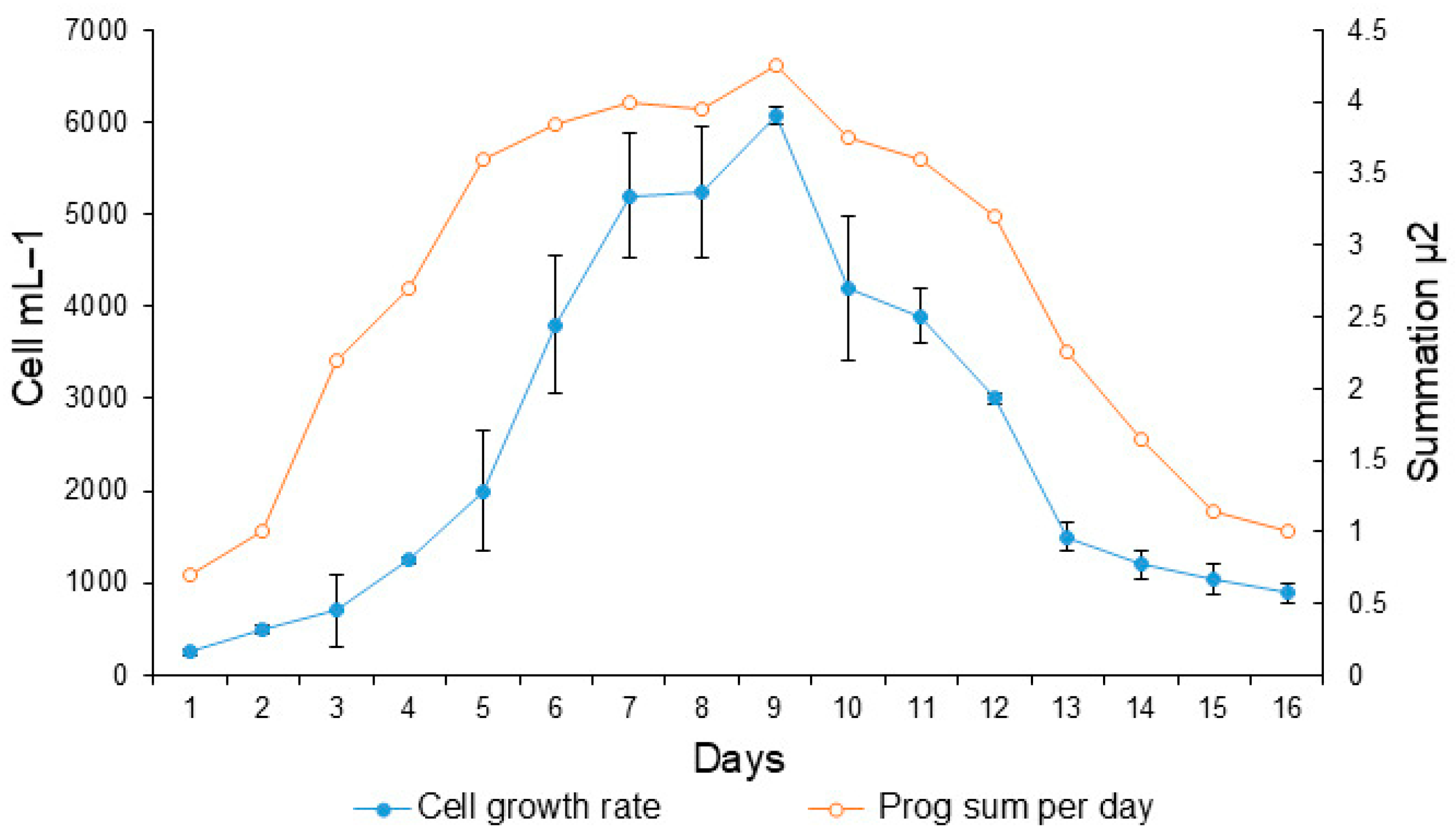

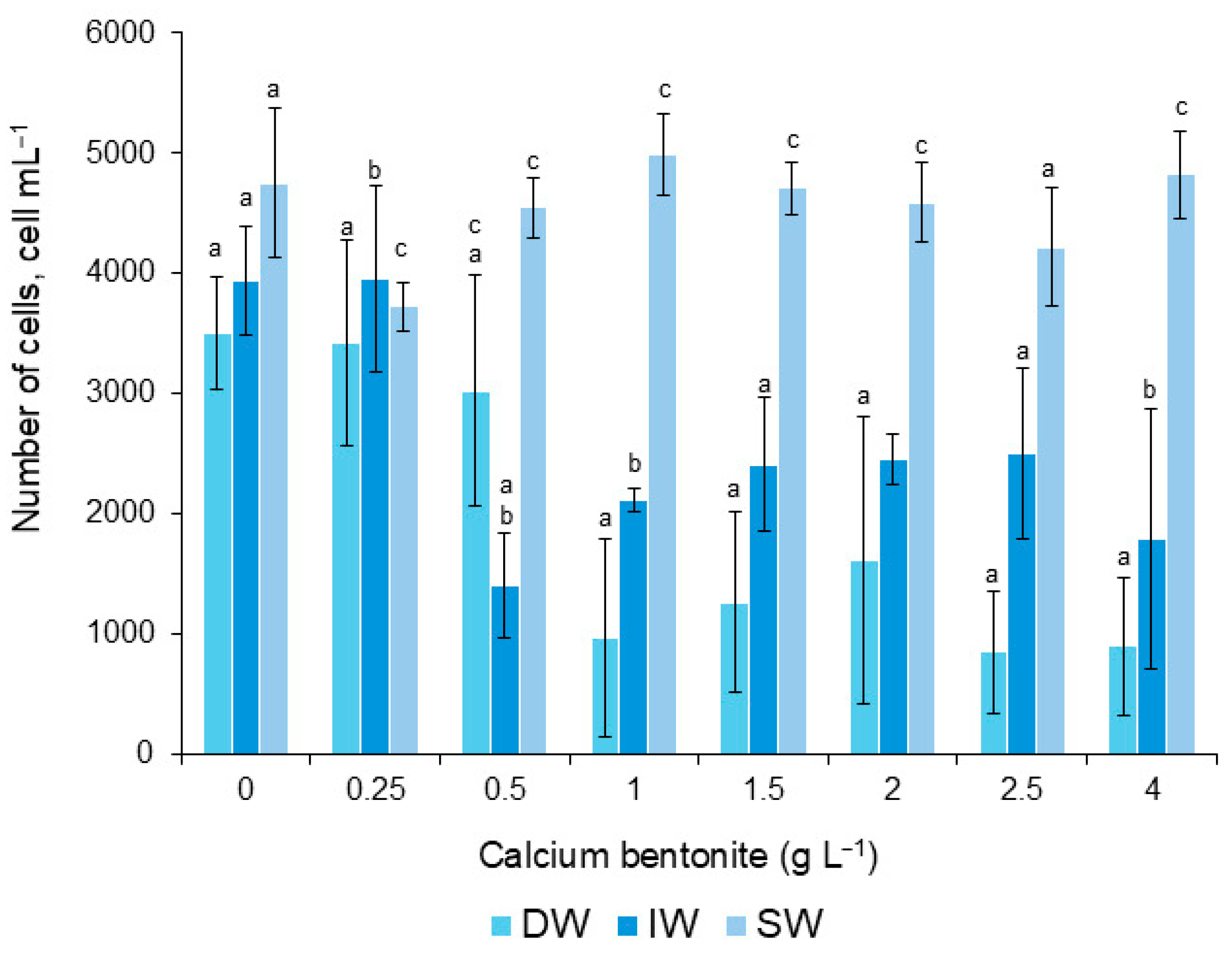
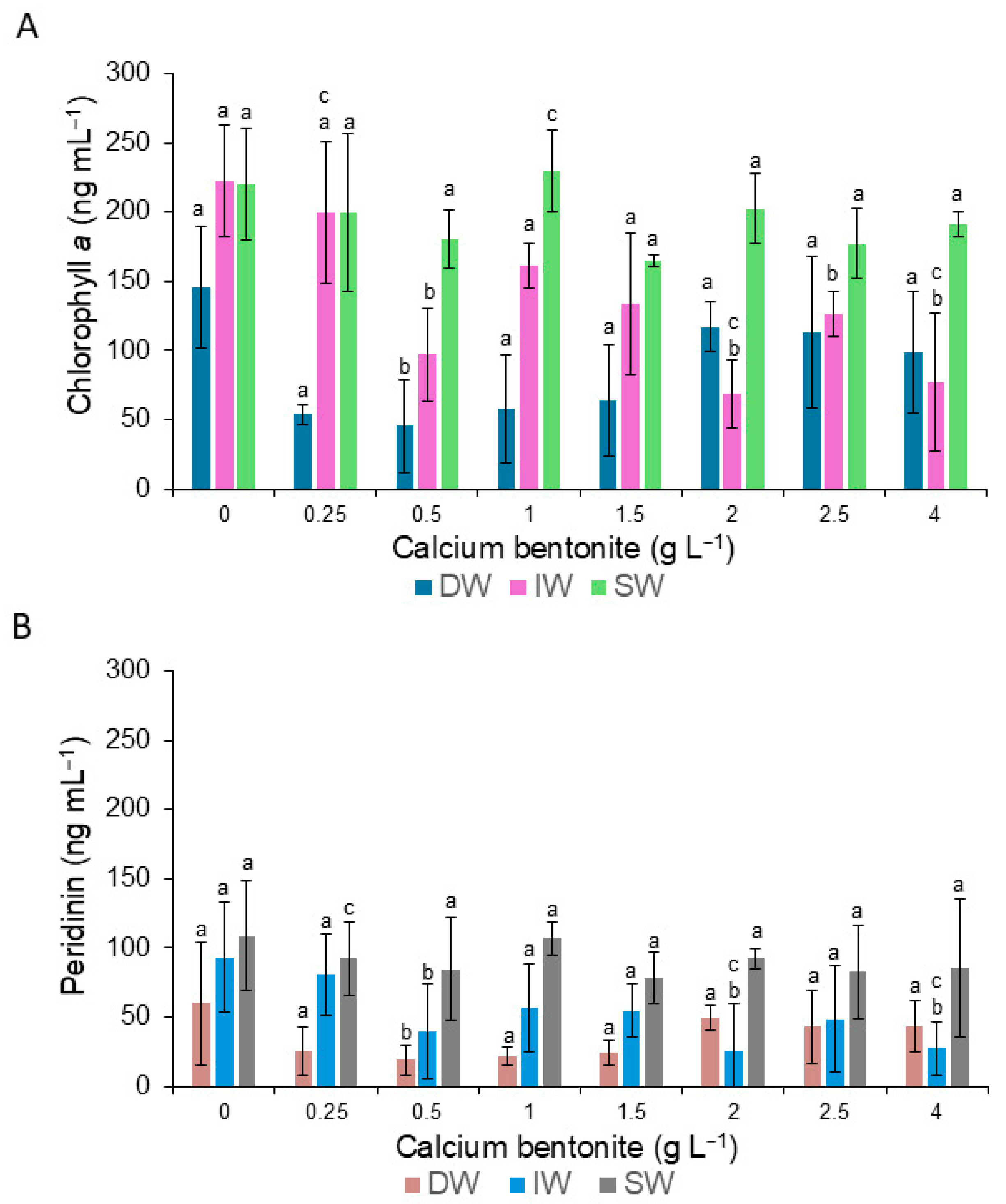


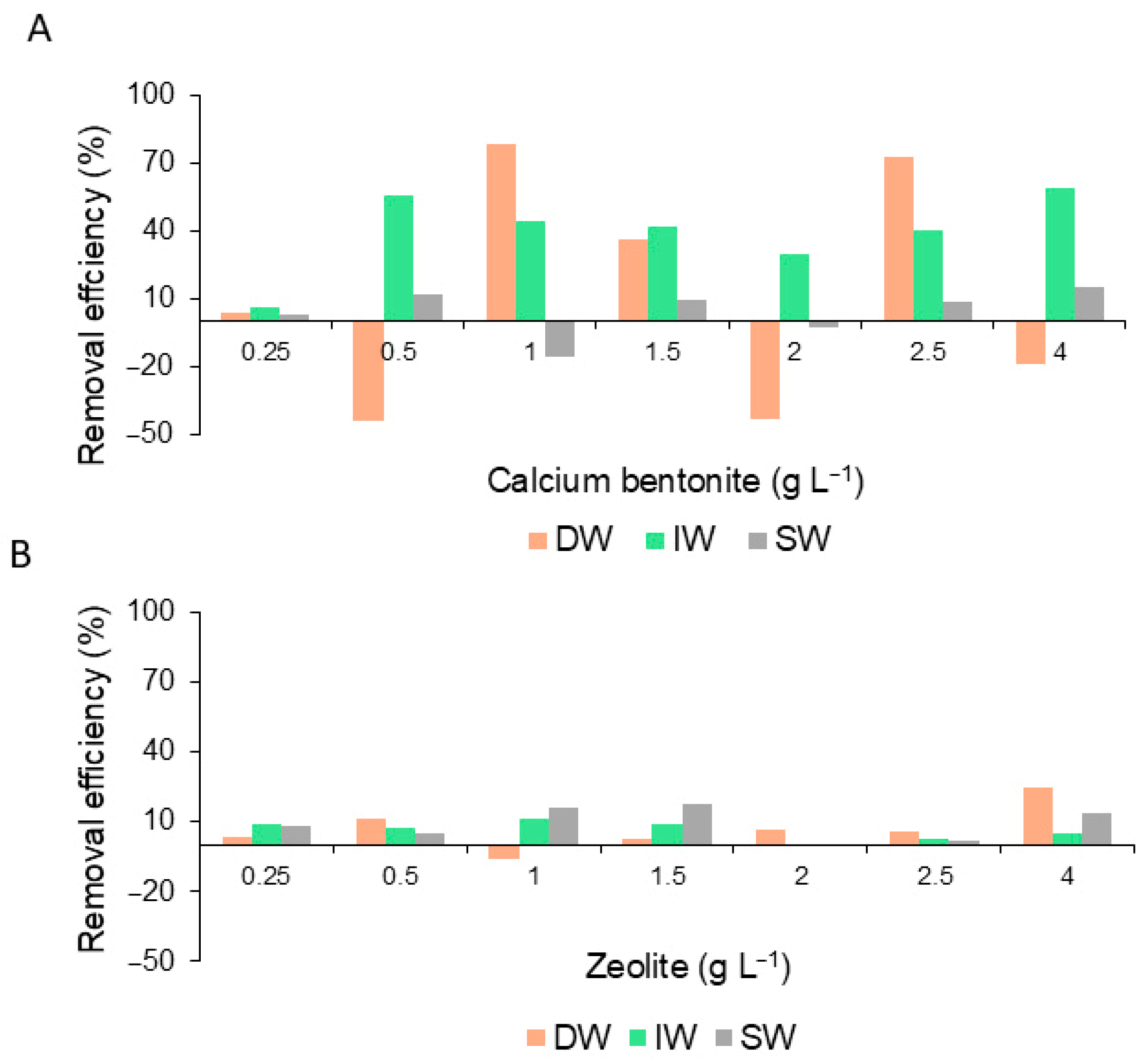
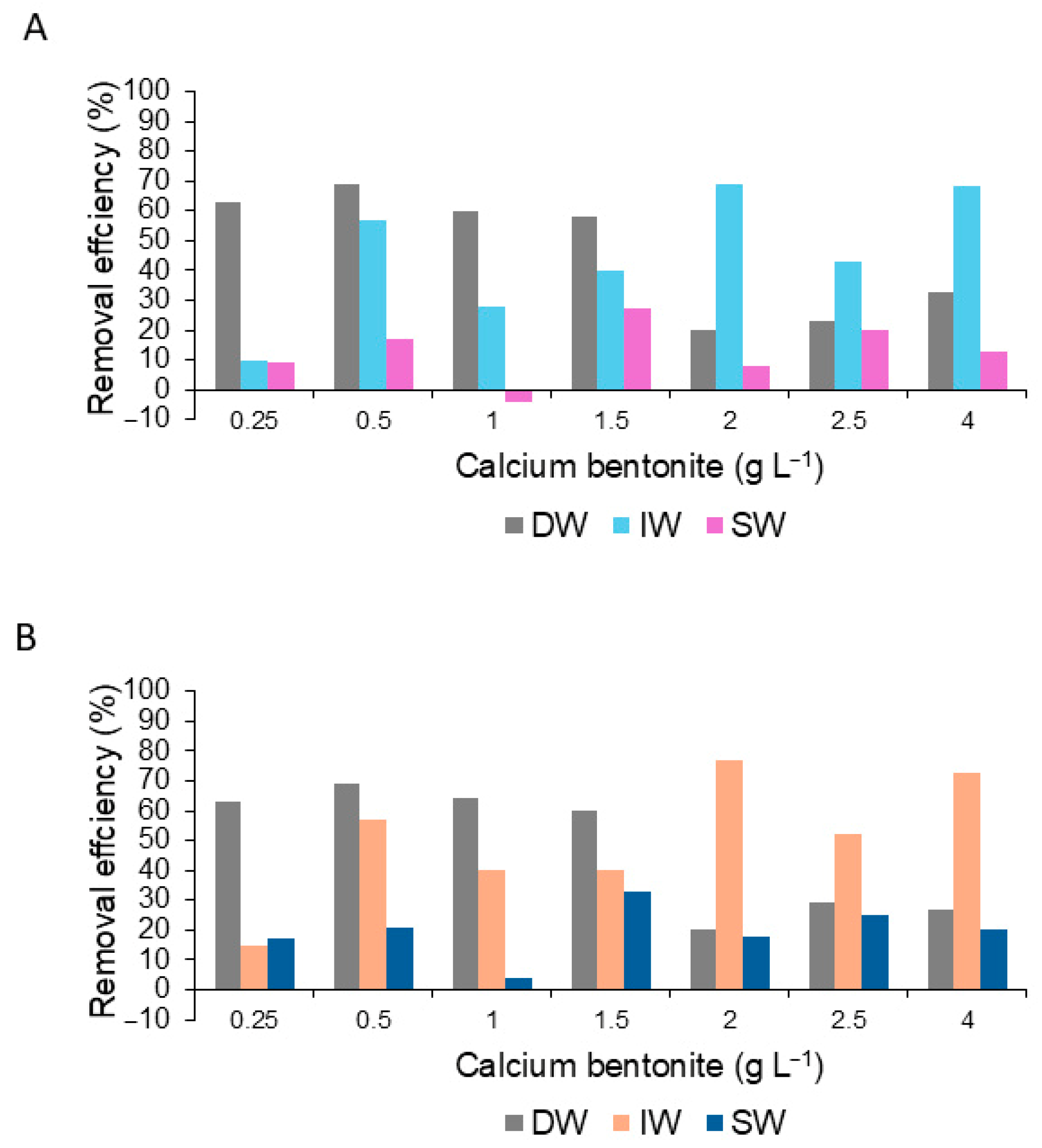
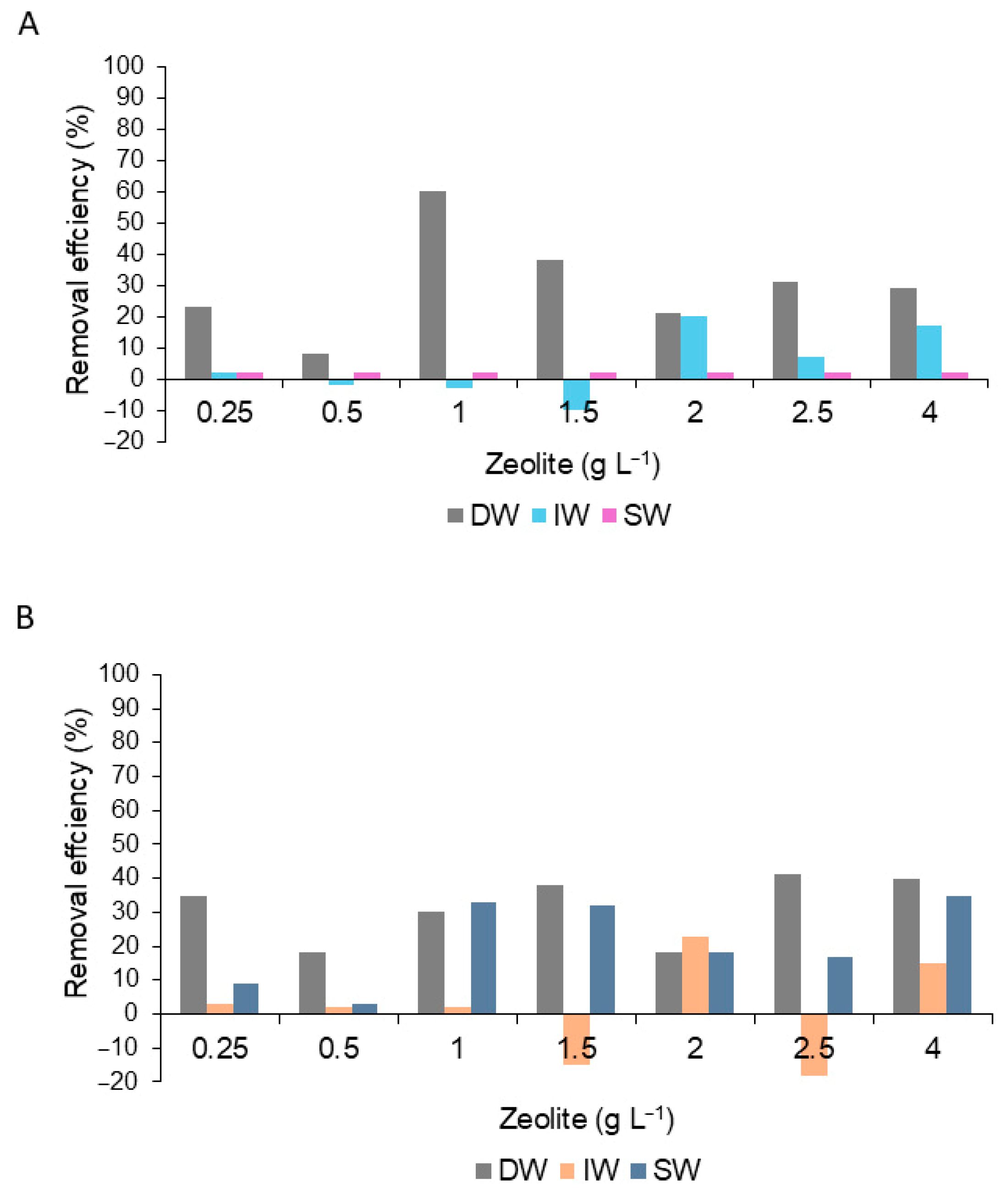

| Clay | Species | Removal Efficiency RE (%) | Reference |
|---|---|---|---|
| Ball clay | G. sanguineaum | ˂70 | Padilla et al., 2010 [41] |
| Caolin, red clay, and montmorillinitin | G. catenatum | ˂40 | Fausto-Sotelo and Alonso-Rodríguez, 2016 [45] |
| Red clay and montmorillonite, clinoptilolite, calciumoxide, calciumhydroxide, aluminum sulfate, chitosan, activated silica, and polyaluminum chloride | G. catenatum | ≤12–99 | Cuellar-Martínez et al., 2016 [46] |
| Ball clay | G. catenatum | 81.2–88 | Rivera and Azanza, 2016 [44] |
| Ball clay (kaolinitic) | G. catenatum | 80–90 | Rivera et al., 2014 [43] |
| Bentonite Zeolite | G. catenatum | 78.7 ˂40 | This study |
Disclaimer/Publisher’s Note: The statements, opinions and data contained in all publications are solely those of the individual author(s) and contributor(s) and not of MDPI and/or the editor(s). MDPI and/or the editor(s) disclaim responsibility for any injury to people or property resulting from any ideas, methods, instructions or products referred to in the content. |
© 2025 by the authors. Licensee MDPI, Basel, Switzerland. This article is an open access article distributed under the terms and conditions of the Creative Commons Attribution (CC BY) license (https://creativecommons.org/licenses/by/4.0/).
Share and Cite
Hernández-Sandoval, F.E.; Núñez-Vázquez, E.J.; Fernández-Herrera, L.J.; García-Zendejas, J.; Cruz-Villacorta, A.A.; Bustillos-Guzmán, J.J.; Ceseña-Ojeda, D.O.; López-Cortés, D.J. Removal and Temporary Cyst Formation of Gymnodinium catenatum (Dinophyceae) Using Calcium Bentonite Clay and Zeolite. Phycology 2025, 5, 61. https://doi.org/10.3390/phycology5040061
Hernández-Sandoval FE, Núñez-Vázquez EJ, Fernández-Herrera LJ, García-Zendejas J, Cruz-Villacorta AA, Bustillos-Guzmán JJ, Ceseña-Ojeda DO, López-Cortés DJ. Removal and Temporary Cyst Formation of Gymnodinium catenatum (Dinophyceae) Using Calcium Bentonite Clay and Zeolite. Phycology. 2025; 5(4):61. https://doi.org/10.3390/phycology5040061
Chicago/Turabian StyleHernández-Sandoval, Francisco E., Erick J. Núñez-Vázquez, Leyberth J. Fernández-Herrera, Jannette García-Zendejas, Ariel A. Cruz-Villacorta, José J. Bustillos-Guzmán, Daniel O. Ceseña-Ojeda, and David J. López-Cortés. 2025. "Removal and Temporary Cyst Formation of Gymnodinium catenatum (Dinophyceae) Using Calcium Bentonite Clay and Zeolite" Phycology 5, no. 4: 61. https://doi.org/10.3390/phycology5040061
APA StyleHernández-Sandoval, F. E., Núñez-Vázquez, E. J., Fernández-Herrera, L. J., García-Zendejas, J., Cruz-Villacorta, A. A., Bustillos-Guzmán, J. J., Ceseña-Ojeda, D. O., & López-Cortés, D. J. (2025). Removal and Temporary Cyst Formation of Gymnodinium catenatum (Dinophyceae) Using Calcium Bentonite Clay and Zeolite. Phycology, 5(4), 61. https://doi.org/10.3390/phycology5040061








